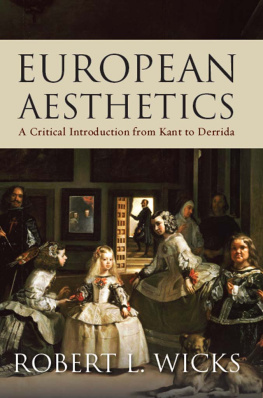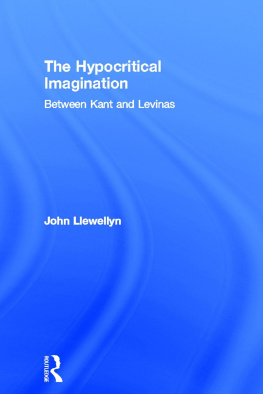Praise for European Aesthetics:
Robert Wicks has an encyclopedic knowledge of the history of continental European aesthetics between 1790 and 1990. His book will be of use to both scholars and advanced students.
Dabney Townsend, Secretary-Treasurer/Executive Director, American Society for Aesthetics
A highly accessible and richly contextualized guide to the history of continental European aesthetics... A valuable resource for historically-oriented courses in aesthetics and philosophy of art.
Sandra Shapshay, Assistant Professor of Philosophy, Indiana University

A Oneworld Book
Published by Oneworld Publications 2013
This ebook edition published in 2013
Copyright Robert L. Wicks 2013
The moral right of Robert L. Wicks to be identified as the Author of this work has been asserted by him in accordance with the Copyright, Designs and Patents Act 1988
All rights reserved
Copyright under Berne Convention
A CIP record for this title is available from the British Library
Hardback ISBN 978-1-85168-818-0
Paperback ISBN 978-1-85168-819-7
eBook ISBN 978-1-78074-077-5
Typeset by Cenveo Publisher Services, Bangalore, India
Oneworld Publications
10 Bloomsbury St
London WC1B 3SR
England
Stay up to date with the latest books, special offers, and exclusive content from Oneworld with our monthly newsletter
Sign up on our website
www.oneworld-publications.com
For Gladys, Valentina and David
PLATES
All the plates with the exception of Plate 2 are from Wikimedia Commons to whom the author expresses his gratitude.
All of the images of works over 100 years old are in the public domain.
ACKNOWLEDGEMENTS
I would like to extend my gratitude to Oneworld Publications, who initially suggested the idea for this book, and to Mike Harpley at Oneworld, who allowed it to mature slowly.
Thanks are also due to the Heads of the Department of Philosophy at the University of Auckland whose tenures covered the duration of this books composition, Tim Dare and John Bishop, along with the Dean of Arts, Jan Crosthwaite, who respectively scheduled reduced administrative assignments, granted academic leave and secured special building access that allowed me to complete this book more effectively than would otherwise have been possible.
In connection with the Kant chapter, I would like to thank Donald Crawford; for the chapters on Hegel, Schopenhauer, Freud and Benjamin, Ivan Soll; for the Marx chapter, Paul Warren; for the Heidegger chapter, Julian Young; for the Gadamer chapter, Matheson Russell; for the Foucault chapter, Stephen Davies. These individuals have been among my friends, colleagues and teachers who, through discussions or professional interactions of one kind or another, have shaped my views on the theorists here addressed. I am also indebted to two anonymous reviewers for Oneworld, whose insights and constructive criticisms significantly improved the manuscript. Thanks are also due to Routledge Publishing, for having given permission for me to draw from my Foucault entry in The Routledge Companion to Aesthetics.
My gratitude also extends to my research assistant, Daniel Wilson, and to the students in my History of Aesthetics, Kant and Hegel, Schopenhauer and Nietzsche, and Twentieth-Century French Philosophy classes at the University of Auckland, whose presence, maturity and intellectual enthusiasm motivated me to formulate some of the leading ideas contained herein.
The birth of my son, David, during the course of this books development, almost on the birthday of Immanuel Kant, our initial theorist, and exactly during the scheduled time of my KantHegel class at the University of Auckland (which had to be cancelled that morning for his arrival), rendered the memories of this books composition that much more exciting and meaningful. My wife, Gladys, and my daughter, Valentina, also deserve great thanks, as they open-mindedly allowed me some peaceful months of time to write in New York that otherwise would have been spent travelling happily with them while they were in South America. I dedicate this book to my beautiful wife and children.
Auckland, April 24, 2012
INTRODUCTION: ART AND THE DISILLUSIONMENT IN REASON
This book surveys sixteen theorists mostly philosophers, but also representatives from literary criticism, psychiatry, classics, and history whose work informs European aesthetics during the last two centuries. The arrangement is chronological on the whole, where the sequence of writers is further grouped according to their geographical origination and shared assumptions. For the sake of expository balance, the presentation divides evenly within each century between those who tend to respect reasons capacities for enlightenment versus those who question its power. Reflected in their various conceptions of reason are ethical or political agendas that, as we shall see, usually predominate over their aesthetic views. Two broad strands of thought are consequently exposed, one rationalist and the other anti-rationalist, that extend side by side from 1790 to 1990, where our account ends, but where contemporary history also continues along the same dual tracks, albeit now more confusingly amalgamated. These are broad strands, for each thinker embodies a particular proportion of rational and anti-rational aspects which render the comparisons and contrasts between them more subtle and often less oppositional.
This expository design reflects a seminal theme that extends across these 200 years and illuminates this time-segment of aesthetic theorizing, namely, the disagreement over the nature and value of reason. During the Enlightenment and culminating in the French Revolution, reason reaches a point where it is celebrated absolutely as the essence of God himself, or simply as the new God to replace those of traditional religions, and in particular Christianity. Optimistic applications of reason in science, politics, social organizations, and psychology a trend that continues today are prescribed here as the most truth-oriented and advisable ways to understand and manage our surroundings. Such ideals inhere in some of the French Revolutions advocates and sadly, eventual victims, such as the Marquis de Condorcet (174394).
The French Revolutions descent into a Reign of Terror left subsequent thinkers perplexed about how reason could turn irrationally and violently upon itself. Some philosophers, such as G. W. F. Hegel, reacted by developing a new, conflict-absorbing conception of reason a reconciliatory and integrative style of rationality based on the structure of self-consciousness upon which to ground a more comprehensive vision of metaphysical truth and social harmony, as well as a position on beauty and art in human history. Others, such as Friedrich Nietzsche, regarded excessive reason as mainly a source of illusion and illness, despite how it can console weaker souls, often through art, in the face of the worlds irrationality. Notwithstanding the contrasting attitudes towards reason that Hegel and Nietzsche represent, most theorists of the time share the idea one that endures to the present, and which accounts for much contemporary interest in aesthetic theory that a resurrection of art and beauty offers a means to greater insight and social salvation. Some link art and beauty to reason in a continued pursuit of Enlightenment ideals, whereas others establish a sharp antagonism between poetry and science, but both camps regard art as a means of rescue and recovery. Virtually all of the thinkers in this study assign ethical, political, and pedagogical roles to beauty and art, roles which govern their aesthetic theories, sometimes to the point where aesthetic values are rendered dramatically subservient, as in Marxist aesthetics.
Next page












